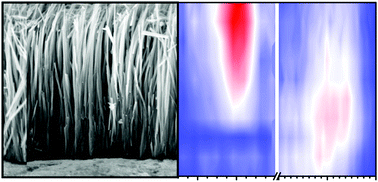当前位置:
X-MOL 学术
›
Nanoscale Horiz.
›
论文详情
Our official English website, www.x-mol.net, welcomes your feedback! (Note: you will need to create a separate account there.)
Gradient in defect density of ZnO nanorods grown by cathodic delamination, a corrosion process, leads to end-specific luminescence
Nanoscale Horizons ( IF 9.7 ) Pub Date : 2017-09-20 00:00:00 , DOI: 10.1039/c7nh00111h Danish Iqbal 1, 2, 3 , Adnan Sarfraz 1, 2, 3 , Andreas Erbe 1, 2, 3, 4, 5
Nanoscale Horizons ( IF 9.7 ) Pub Date : 2017-09-20 00:00:00 , DOI: 10.1039/c7nh00111h Danish Iqbal 1, 2, 3 , Adnan Sarfraz 1, 2, 3 , Andreas Erbe 1, 2, 3, 4, 5
Affiliation

|
ZnO nanorods were grown on a zinc substrate via cathodic delamination of a polymer coating, a tailored corrosion process, at room temperature. A comparison between in situ Raman spectra and post mortem cross sectional analysis by Raman spectroscopy, photoluminescence spectroscopy and scanning electron microscopy shows that in the initial stages of the synthesis, preferentially defect rich ZnO grows. At later stages, crystalline wurtzite ZnO growth dominates. The result is nanorod arrays consisting of nanorods with a large density of point defects in the ≈500 nm range near the zinc substrate, and low defect density in the regions further away from the interface. The growth, which proceeds over several hours, can be interrupted at any time. Large salt concentrations in the corrosive medium increase the growth rate, but also the amount of point defects. The resulting rods show strongly position-dependent luminescence and Raman spectra. Different luminescence can thus be selectively excited, based on the position of excitation.
中文翻译:

通过阴极分层,腐蚀过程生长的ZnO纳米棒的缺陷密度梯度导致最终特定的发光
ZnO纳米棒在室温下通过聚合物涂层的阴极分层,定制的腐蚀工艺在锌基板上生长。原位比较通过拉曼光谱,光致发光光谱和扫描电子显微镜的拉曼光谱和事后横截面分析表明,在合成的初始阶段,优先生长富含缺陷的ZnO。在以后的阶段,结晶纤锌矿ZnO的生长占主导地位。结果是纳米棒阵列由纳米棒组成,这些纳米棒在锌基底附近的≈500nm范围内具有大的点缺陷密度,而在远离界面的区域中的缺陷密度低。生长持续数小时,可以随时中断。腐蚀性介质中较大的盐浓度会增加生长速率,还会增加点缺陷的数量。所得的棒显示出强烈的位置依赖性发光和拉曼光谱。因此可以选择性地激发不同的发光,
更新日期:2017-09-20
中文翻译:

通过阴极分层,腐蚀过程生长的ZnO纳米棒的缺陷密度梯度导致最终特定的发光
ZnO纳米棒在室温下通过聚合物涂层的阴极分层,定制的腐蚀工艺在锌基板上生长。原位比较通过拉曼光谱,光致发光光谱和扫描电子显微镜的拉曼光谱和事后横截面分析表明,在合成的初始阶段,优先生长富含缺陷的ZnO。在以后的阶段,结晶纤锌矿ZnO的生长占主导地位。结果是纳米棒阵列由纳米棒组成,这些纳米棒在锌基底附近的≈500nm范围内具有大的点缺陷密度,而在远离界面的区域中的缺陷密度低。生长持续数小时,可以随时中断。腐蚀性介质中较大的盐浓度会增加生长速率,还会增加点缺陷的数量。所得的棒显示出强烈的位置依赖性发光和拉曼光谱。因此可以选择性地激发不同的发光,



























 京公网安备 11010802027423号
京公网安备 11010802027423号